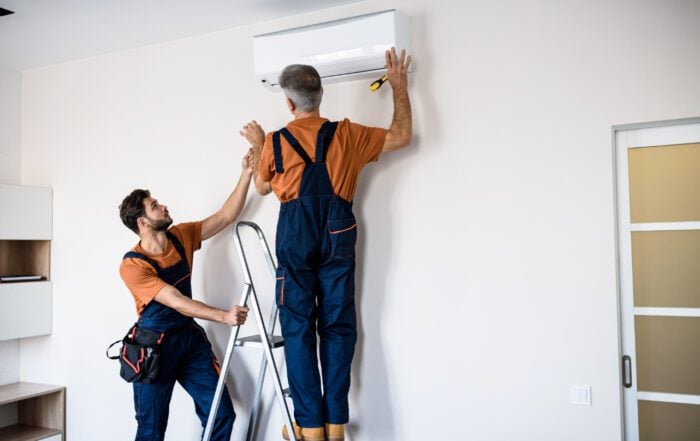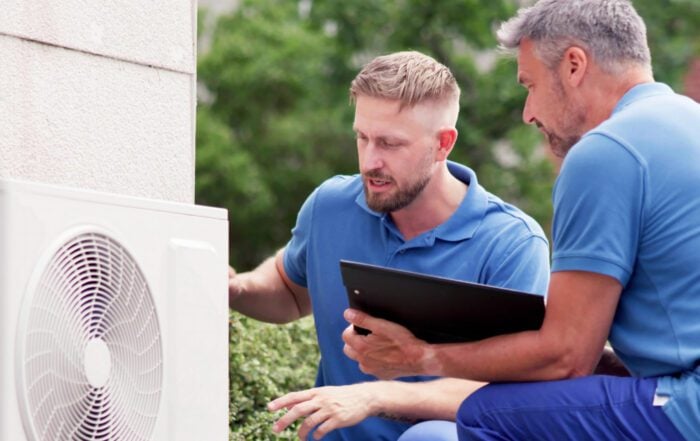A recent study suggests there will be an increase in worldwide demand for major appliances: 445 million units by 2019.
With so many major appliances being replaced or added to a home for the first time, households all over will need to work to keep them running for years to come. And that means regular maintenance.
Every major appliance in your home has some regular-maintenance tasks you can perform by yourself.
Air Conditioners
Check your unit for debris before shutting it down for the season. It’s easy for leaves, twigs, and other outdoor debris to collect in this major appliance during the warm weather. To keep it from damaging your system over the colder seasons, you’ll want to clean it out before covering it up. Remove the fan cage and use your hands ora wet/dry vacuum to clear out anything inside the unit. You’ll also want to rake away anything around the unit – and make sure to do that occasionally during use.
Clean the coils. The evaporator and condenser coils tend to collect dirt and grime over time, even with clean filters. You’ll want to check the coils at least once a year and clean them as necessary (especially the outdoor condenser coil which has a tendency to become dusty and trap debris).
Change the filter. This should be done at least twice yearly: in the fall before you turn your heat on and in the spring before you turn on your air conditioning. You’ll most likely need to change it more often – four times a year is common – but twice is the absolute minimum.
Unclog the drain. Because the drain channels can occasionally become clogged and you may see water on the floor around the furnace, it doesn’t hurt to pass a stiff wire through them once in awhile.
Dishwashers
Clean the trap. Every dishwasher is a little different, but they all work the same way and have similar components. One of these components is the trap in the bottom of the dishwasher which collects food particles. You should occasionally remove this to clear away any loose food and dried soap.
Clean the spray-arms. If you look at the arm(s) on the bottom (and sometimes the top), you’ll notice a pattern of small holes. This is where the water sprays out during the cleaning cycle. And just like the trap, these holes can get clogged with debris and dried soap. Occasionally remove the arm and soak in a mixture of vinegar and water, using pipe-cleaners on the holes.
Washers and Dryers
Make sure your washer and dryer are installed properly. The best way to ensure this is to have a professional complete the installation.
Inspect the hose. The hose attachment on this major appliance can wear down over time, so check it monthly for cracks or bulges and to make sure the fittings are tight.
Keep it clean. Yes, the inside of your washer can become dirty. Residue can collect and cause the mildew-like smell you can often catch. (Check out this site for tips on keeping your washer and dryer clean.)
Maintain the lint filter. Always remember to clean the lint trap before each load of laundry. You might even consider drying an item for half the time and cleaning the filter before running another cycle if the item could create a heavy lint buildup.
Check the vent. Check the outside vent occasionally to ensure air is coming out when the dryer is in use. If it’s not, there could be a blockage in the vent such as lint accumulation, a bird’s nest, or a small animal – especially in the colder weather when they are drawn to the warmth.
Refrigerators and Freezers
Occasionally check the door seals. As you open and close the doors on a regular basis, the seals begin to pull away. When the seal is loose, the cool air seeps out which causes your fridge to continually work to replace what was lost. Try the dollar bill test: close a dollar bill in the refrigerator so it’s half inside and half outside; if it slips out easily when you pull on it, you should consider replacing the seals.
Clean the door seals. Even if they’re functioning like they should and not pulling off of the door, food particles can get stuck in the creases. Go over them twice a year with a toothbrush and a cleaning solution to keep them in shape.
Fill it up. Even if you don’t cook at home much, it’s important to keep a heavy “mass” in your fridge and freezer – they need this in order to maintain the low temperatures. Those cooled items help absorb the warm air when you open the door.
Stoves
Clean and maintain it regularly. You want to do this as often as possible, but make sure to do this at least once a month. Always clean your stove when it’s cool to the touch, and browse your owners manual for maintenance tips specific to your major appliance.
Put a fire safety plan in place. When you work with major appliances that utilize gas or heat up open pans of oils, you have a fire risk on your hands. Make sure you put a safety plan into place.
Tip: Keep baking soda on hand in case you need to quickly put out a small grease fire.
Quickly clean up spills. Whether it’s something that boiled over on the stove or a casserole that dripped to the bottom of the oven, it’s always easier to clean it up as soon as the mess happens. And it helps prevent damage.
You can switch out the elements if they aren’t working properly. Always consult your owner’s manual before you attempt any replacements. If you feel comfortable enough switching them out yourself, here are the steps you’ll need to follow. If you are not comfortable with this task, contact a professional.
Water Heaters
Inspect the pressure valve. There is a temperature and pressure relief valve (T&P valve) on both gas and electric water heaters. This safety device opens to release the pressure in this major appliance when the tank over-pressurizes. If it doesn’t open correctly when that happens, the tank can explode.
Tip: If you don’t hear a rush of air or notice water and vapor leaking from the valve when you check it, you need to replace it.
Flush the tank. Over time, sediment can build up inside the tank, clog the lines, and reduce your water heater’s efficiency. When you check the pressure relief valve, flush the tank as well.
Check for leaks and drips. These can occur over time from faulty water supply connections. Replacement compression fittings are fairly easy to install yourself, but if you’re working with copper pipes or aren’t comfortable with doing the repair yourself, contact your local contractor to replace the connections for you.
Microwaves
Leave the electronics to a professional. Don’t try to make any changes yourself when it comes to the wiring of your appliance. Not only does it void the warranty but it can be dangerous as well – even a small unit can hold high levels of electricity. But due to the price of a new microwave versus replacement parts, it’s often easier to purchase an updated model.
Be careful when closing the door. Avoid slamming it at all costs. The latches on the major appliance often have to close in a particular order, and slamming the door can alter that order. This can end up in a blown internal fuse.
Plug it into a surge suppressor. To avoid any surge damage from storms or power failures, make sure you use a protected outlet.
Follow these simple DIY steps to keep your home’s major appliances running in tip-top shape. And if they get to be too far outside of your comfort zone, contact your local handyman or contractor like Stack to lend a hand.
Have Any Questions?
If this is an emergency please call 440-937-9134.
Otherwise, please feel free to call us or submit this form to schedule an appointment for service or request an estimate. We will contact you shortly!



